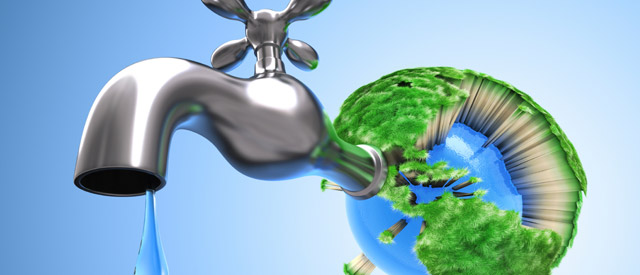 Urban planning and water management need integrating
Urban planning and water management need integrating
New research has investigated the combined impact of climate change and land cover change on external household water consumption and local night-time temperatures. It estimates that a 3ºC rise in temperature combined with a high degree of urban sprawl would increase water consumption by 4,061 litres per household for the month of August due to increases in evaporation from ground surface. The study recommends full integration of land use planning and water management.
Two concerns for sustainable urban development are increases in water consumption and the urban heat island (UHI) effect, whereby building materials in cities, such as concrete and asphalt, retain heat and create local warming. Two significant influences on these phenomena are climate change and land cover change, particularly changes in the level of vegetation.
The study aimed to quantify the combined effect of land cover change and climate change on water consumption and the degree of cooling at night during the summer season in nine residential neighbourhoods of Hillsboro, USA, a suburban city in the Portland metropolitan area, facing future population growth and climate change. It was assumed that the change in external household water consumption i.e. on gardens etc. could be approximated by the change in evaporation of water from the urban land surface as more evaporation would result in increasing water requirements outside.
The study used the ‘local-scale urban meteorological parameterisation scheme’ (LUMPS) to model heat fluxes at the land surface, using meteorological and land cover data for each of the neighbourhoods for the month of August. Three climate change scenarios for the 2040s were downscaled from the IPCC Fourth Assessment Report1: low, medium and high.
Two land cover change scenarios were used: urban sprawl and urban densification. Urban sprawl assumes a loosening of land use laws so a greater area of land is developed, whilst urban densification constrains future building, which results in more houses being built on already developed land. Unsurprisingly, of the three climate change scenarios, the high climate scenario produced the greatest increase in water evaporation (2,691 litres) and far less night-time cooling.
For the land cover changes, urban sprawl increased evaporation and therefore external water consumption by 1,265 litres per household for the month of August, mainly the result of increased number of residential lots and therefore more vegetation. This created a positive trade-off, where more cooling occurred at night-time at a rate of 0.105ºC per hour, caused by evaporation from the vegetation.
In comparison, urban densification resulted in a decrease in water evaporation by 1,349 litres, but only slightly less cooling at night. The greatest level of evaporation, 4,061 litres, occurred under the scenario of high climate change combined with urban sprawl.
As water evaporation (and therefore external water consumption) increased, so did night-time cooling, but further examination suggested that there is a threshold – a point at which continued increases in water evaporation would no longer lead to an increase in cooling and temperatures would stay at the same level. In addition, more detailed analysis into type of vegetation revealed that there is a threshold beyond which more grass produces the same cooling effects. For trees, there is no threshold, and increasing tree cover continues to increase night-time cooling.
The research indicates that land cover and water use are intertwined in their effects on urban heat fluxes and this suggests the integration of urban land use planning and water management. Current vegetation and water consumption patterns should be taken into account in development plans, whilst trees should be prioritised over grass for better promotion of urban cooling whilst reducing water consumption.
| Contact information |
Email: lilyhp@email.arizona.edu |
|---|---|
| News type | Inbrief |
| File link |
http://www.ipcc.ch/publications_and_data/publications_and_data_reports.shtml#.T0tsC1Fpvao |
| Source of information | House-Peters, L.A. & Chang, H. (2011) Modelling the impact of land use and climate change on neighbourhood-scale evaporation and nighttime cooling: A surface energy balance approach. Landscape and Urban Planning. 103:139-155. |
| Keyword(s) | Land use, Urban environment, Water |
| Subject(s) | METHTODOLOGY - STATISTICS - DECISION AID , NATURAL MEDIUM , POLICY-WATER POLICY AND WATER MANAGEMENT , RISKS AND CLIMATOLOGY |
| Geographical coverage | n/a |
| News date | 19/03/2012 |
| Working language(s) | ENGLISH |
 you are not logged in
you are not logged in





